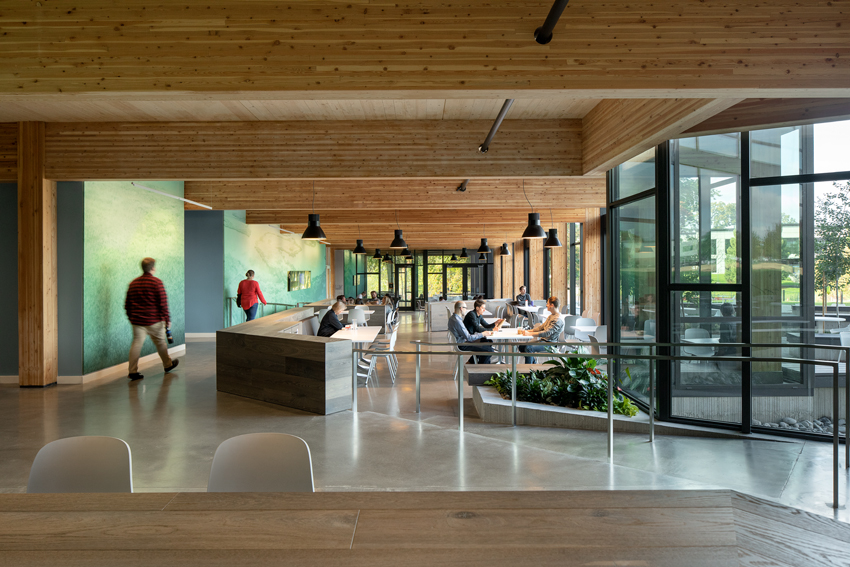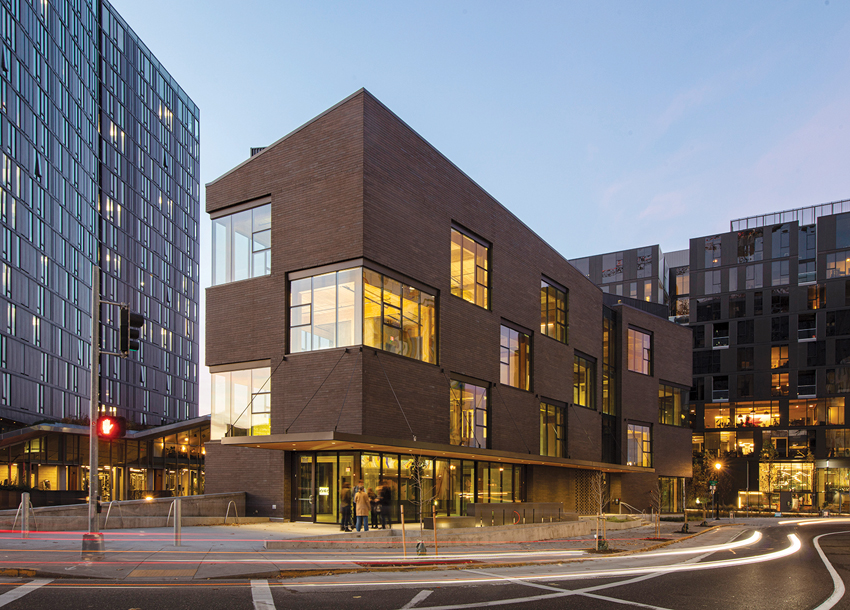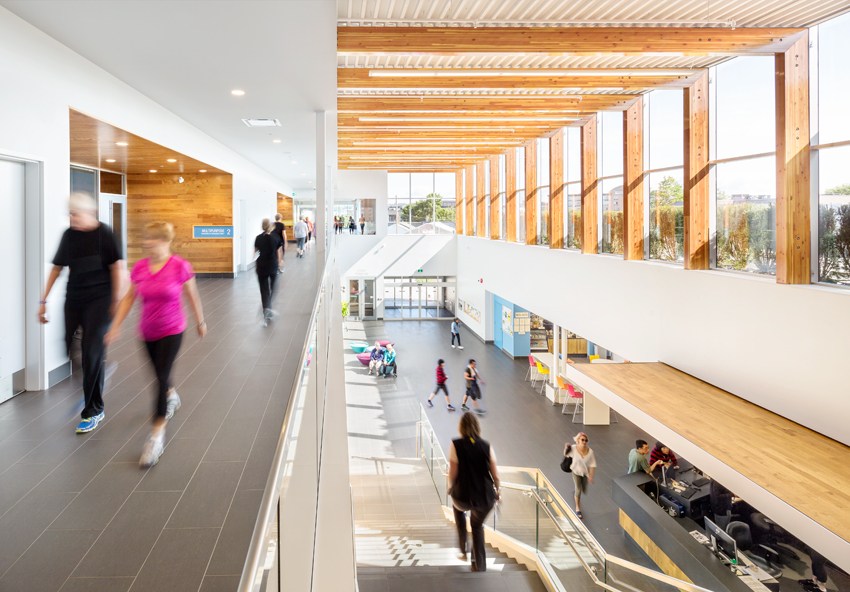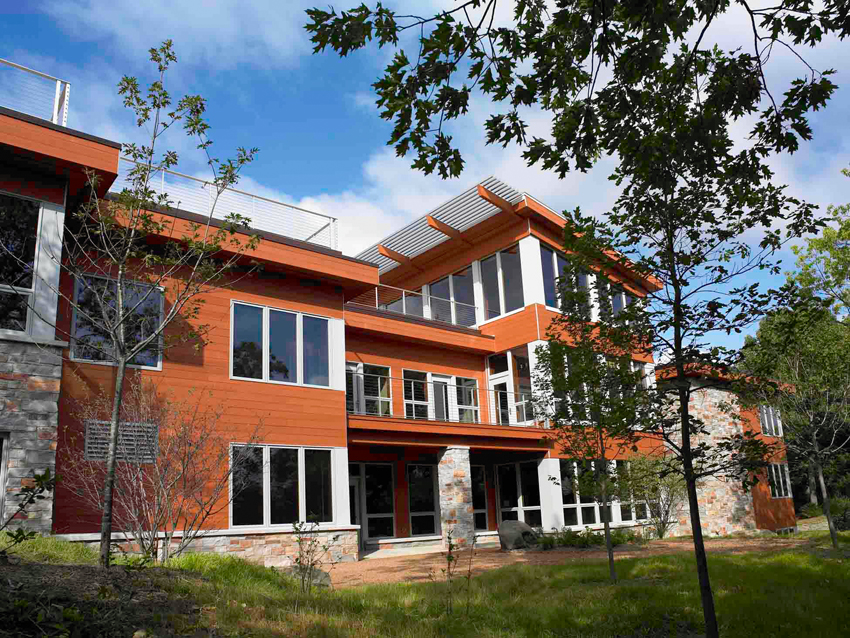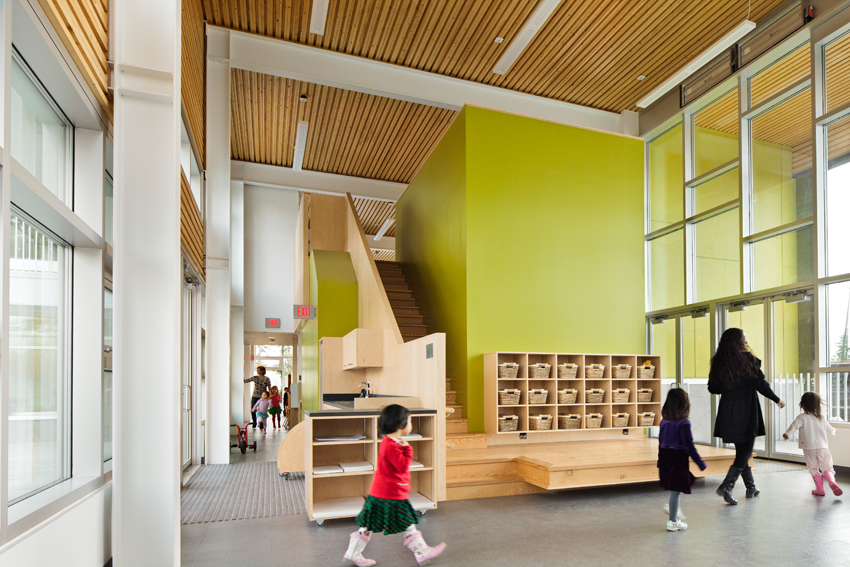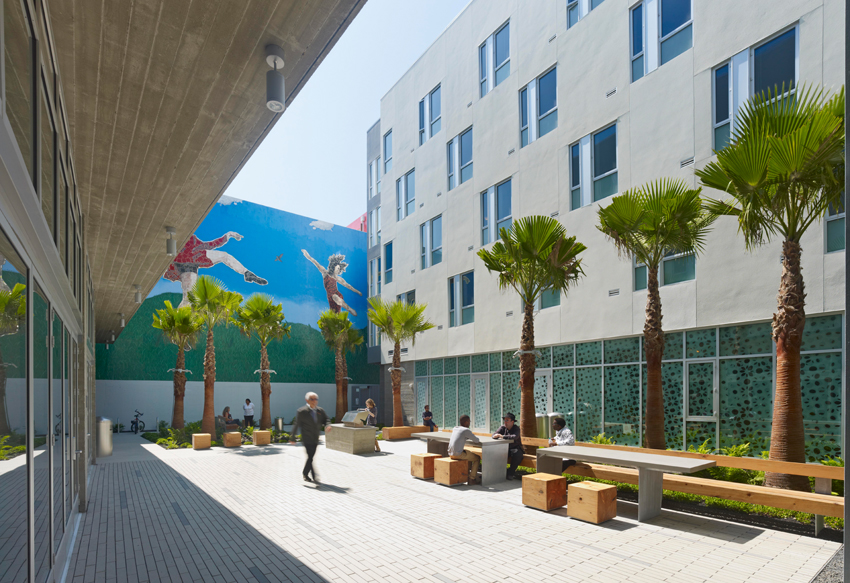Retail Customer Experience
In its report, “The Economics of Biophilia,” Terrapin Bright Green quantified the importance of nature in retail spaces, framing the discussion around how natural design elements can be used to draw shoppers in and boost sales for a retail establishment. The report showed that retail customers judge businesses surrounded by nature and natural features, finding them to be worthy of prices up to 25 percent higher than businesses with no access to nature.31
Certainly, part of the allure of nature in a retail space is provided by natural plants that are so predominant in shopping areas. But architects have taken the concept beyond foliage. Natural daylighting is essential; companies like Target and Wal-Mart have reported significantly higher sales in departments that had natural lighting.32
Something as simple as just the presence of exposed wood within the retail establishment gets noticed by shoppers and is also equated with a positive shopping experience.
The COVID-19 pandemic has had a devastating impact on retailers, and challenges are expected to remain for some time. Many expect that consumers will be hesitant to return to stores and malls, giving designers new priorities for creating spaces that foster a sense of health and wellness.

Source: Could Biophilic Design Impact a Brand’s Bottomline?39
Wellness-Oriented Building Standards
In the past few decades, we have seen growing interest in green building standards, promoting sustainable building practices intended to create a healthier global environment. We are now seeing the same trend toward wanting to promote the well-being of building occupants inside. It is another indicator of the growing understanding that design and construction of buildings do matter to the human experience, and recognition that building design holds the potential to contribute to an occupant’s overall sense of well-being.
Like green building standards, wellness-oriented building standards are optional. Some entities may require that a project be designed to include natural elements without specifying a building standard. For example, an urban project may require that a building project include a minimum amount of outdoor space, much like some projects require a minimum number of onsite parking spaces.
The trend has led to one new wellness-focused standard, as well as to the addition of wellness considerations within some existing green building standards.
WELL Building Standard
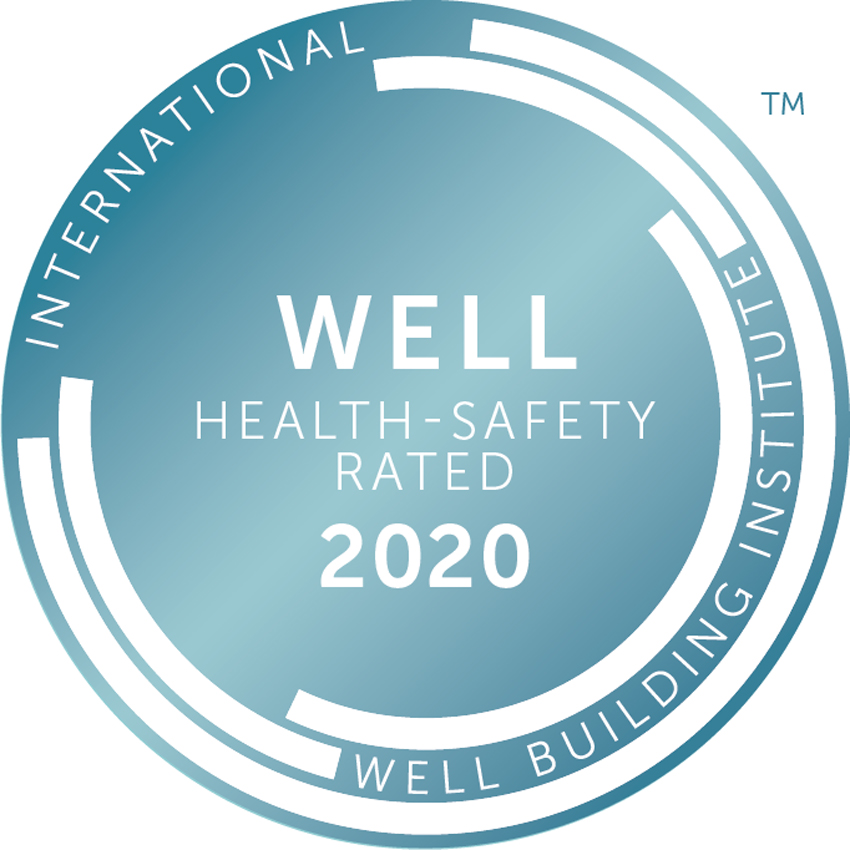 Launched in 2014 by the International WELL Building Institute (IWBI), the WELL Building Standard is a global rating system that seeks to provide framework and guidance for design professionals who want to incorporate wellness-focused building features.
Launched in 2014 by the International WELL Building Institute (IWBI), the WELL Building Standard is a global rating system that seeks to provide framework and guidance for design professionals who want to incorporate wellness-focused building features.
WELL describes the building standard as “a holistic rating system for buildings, interior spaces, and communities. WELL integrates design features with improvements to operational and policy protocols to help organizations instill a culture of health. Ten overarching concepts represent the ways that our physical environment can impact our health, well-being, productivity, and our performance. Strategies address performance metrics such as air and water quality, lighting, and thermal comfort, as well as how an environment can promote healthy eating, physical activity, and emotional and cognitive health.”33
Designers evaluate a building’s performance using WELL assessment tools, grounded in more than 100 health and well-being solutions in 10 concept areas. For example, the standard includes design strategies such as access to nature, as well as design strategies that support productivity to help relieve workplace stress and anxiety, reduce absences, and enhance overall perceived health status.
One of the WELL concept areas, Mind, includes strategies designed to promote mental health, addressing factors that influence cognitive and emotional well-being. WELL v2 has added certification standards with building design points that reward things like physical activity with inviting staircases, ergonomic work areas, and more.
IWBI has recently released a new WELL Health Safety Rating in response to the COVID-19 pandemic. The new rating focuses on “operational policies, maintenance protocols, emergency plans, and stakeholder education to address a post-COVID-19 environment now and broader health and safety-related issues into the future.”34
Living Building Challenge (LBC)
 Living Building Challenge (LBC) is a green building standard from the International Living Future Institute (ILFI) that takes a holistic approach to green building, with a goal to create a building environment that optimizes the psychological health and well-being of occupants.
Living Building Challenge (LBC) is a green building standard from the International Living Future Institute (ILFI) that takes a holistic approach to green building, with a goal to create a building environment that optimizes the psychological health and well-being of occupants.
LBC has seven performance categories, called Petals, which include: Place, Water, Energy, Health + Happiness, Materials, Equity, and Beauty. The Health + Happiness Petal, for example, is specifically focused on creating a healthy interior environment, healthy interior performance, and access to nature. The Beauty Petal addresses beauty and biophilia, stipulating design elements that must be represented in the project to qualify. Examples include environmental features, natural shapes and forms, natural patterns and processes, light and space, place-based relationships, and evolved human-nature relationships.
Note: To better promote what it calls “the design, construction, and operations of healthy and restorative buildings,” the IWBI and the ILFI are working to better align the WELL Building Standard and the Living Building Challenge rating systems, with a goal to allow certain projects to meet dual certification.35
Leadership in Energy and Environmental Design (LEED)
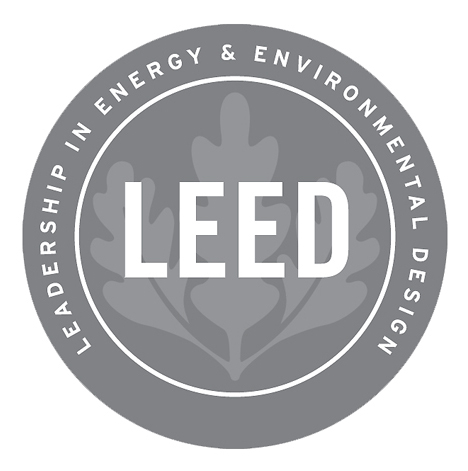 Operated by the U.S. Green Building Council, Leadership in Energy and Environmental Design (LEED) gives designers the ability to earn points for a project by incorporating design measures that are deemed to positively impact the environment, like using sustainable materials or making efficient use of resources. Besides promoting a project’s sustainability features, LEED also acknowledge the importance of designing beneficial spaces for living and working. LEED allows users to apply for pilot credits with LEED v4 by using at least five distinct biophilic design strategies, including material connection with nature, nature of the space, use of indigenous natural materials in the interior finishes of a space, and others.36 For example, a project can earn LEED points by incorporating living walls, sometimes called green walls, into an office space, adding a water feature to a building complex, or featuring exposed wood members and natural rock in a shared space.
Operated by the U.S. Green Building Council, Leadership in Energy and Environmental Design (LEED) gives designers the ability to earn points for a project by incorporating design measures that are deemed to positively impact the environment, like using sustainable materials or making efficient use of resources. Besides promoting a project’s sustainability features, LEED also acknowledge the importance of designing beneficial spaces for living and working. LEED allows users to apply for pilot credits with LEED v4 by using at least five distinct biophilic design strategies, including material connection with nature, nature of the space, use of indigenous natural materials in the interior finishes of a space, and others.36 For example, a project can earn LEED points by incorporating living walls, sometimes called green walls, into an office space, adding a water feature to a building complex, or featuring exposed wood members and natural rock in a shared space.
LEED v4 also has a stronger performance-oriented approach to indoor environmental quality, having added criteria to address things like air quality, lighting, acoustics, and other design factors. Like WELL, LEED has also augmented its program in response to the global pandemic. The LEED Safety First pilot credits address pandemic preparedness and response, workplace reoccupancy steps, sanitation measures, indoor air quality, and more.37
Green Globes
 In 2019, the Green Building Initiative updated Green Globes standards for both Existing Buildings and New Construction, adding a section on Health and Wellness. The new standards consider things like air quality and ventilation, humidity, thermal and acoustic comfort, daylighting, accessibility of staircases, fitness facilities, bicycle commuter facilities, healthy dining options, and more. For example, designers of health-care facilities are asked about measures taken to minimize noise at reception areas to help reduce anxiety and stress on patients and families seeking directions and information from staff.
In 2019, the Green Building Initiative updated Green Globes standards for both Existing Buildings and New Construction, adding a section on Health and Wellness. The new standards consider things like air quality and ventilation, humidity, thermal and acoustic comfort, daylighting, accessibility of staircases, fitness facilities, bicycle commuter facilities, healthy dining options, and more. For example, designers of health-care facilities are asked about measures taken to minimize noise at reception areas to help reduce anxiety and stress on patients and families seeking directions and information from staff.
It is a common human reaction: We turn to nature in uncertain times. Nature nurtures, as they say. With the 2020 global pandemic and limited access to the outdoors it has meant for many, people are looking at their surroundings with new appreciation—and an increased desire for buildings that help them feel good as they spend more time indoors.
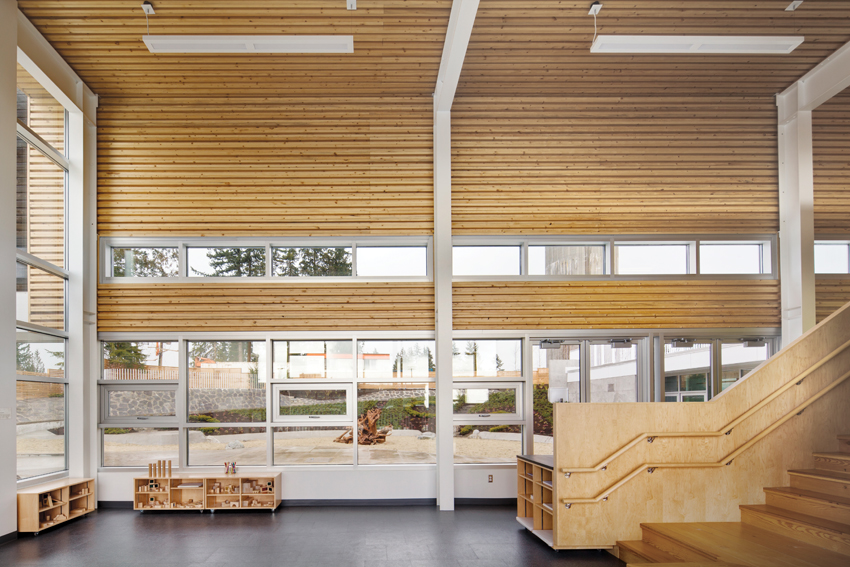
Photo: Martin Tessler
UniverCity Childcare Centre, Simon Fraser University, Burnaby, British Columbia,Canada
While we know that good architecture does not guarantee good health, evidence is growing that a well-designed building can lead to an improved overall sense of well-being for occupants. And, since wood has a natural connection with nature, there is increasing evidence that wood can contribute to the well-being of building occupants when it is left where it can be seen and even smelled.
This course explores the trend toward architecture that is designed to improve the well-being of building occupants.
Building Designs Must Adapt to Changing Market Needs
Occupant health and well-being is more important than ever, especially given the fact that Americans, on average, are currently spending approximately 90 percent of their time indoors.1 As a result, building professionals are seeing the need to rethink how we design, use, and occupy buildings.
COVID-19 is also changing the ways in which buildings are designed. For example, building teams are considering touchless entries, improved ventilation systems, and design features that allow people to spread out with renewed interest. But the increased focus on beneficial spaces is not only on occupant safety; designers are looking for ways to simply improve the way that people feel inside of buildings, even as they need to spend more time inside.
“The spaces where we live and work can have a significant effect on our physical and emotional well-being,” says Ricardo Álvarez-Díaz, founder and principal of Álvarez-Díaz & Villalón, a design firm based in San Juan, Puerto Rico, and Miami. “Thoughtful, innovative design can shape how we feel and what we experience within a physical space.”2
Designing for Wellness: The Power of Nature
Emerging research shows that communities are more apt to thrive when the buildings people occupy are intentionally designed with community wellness in mind. The built environment can have a big influence on the self-perceived well-being of occupants; visual warmth and comfort of an office building tells employees that they are valued, for example, and a warm and friendly entrance tells those who live in a multifamily building that they are welcomed home.
On its website, global design and engineering firm Atkins says, “More and more evidence and guidance is making its way from the medical and research world into the construction industry, highlighting the impact the built environment has on both our physical and mental well-being… Understanding the complexities and interconnected nature of [these] well-being parameters at the very beginning of a building project is the only way to deliver environments that maintain, at their heart, the well-being of those who inhabit them.”3
Certainly, impacts of factors like poor indoor air quality have been well-documented, proven by the increasing recognition of the importance of low-VOC surface treatments and other elements dictated by sustainable design initiatives like LEED. But architects are also recognizing the increasing importance of the overall design that supports human well-being.
This is particularly true for urban populations. The “Green Cities: Good Health” report from the University of Washington’s Urban Forestry Department presents the results of extensive research on the topic of stress, wellness, and physiology.4 “We may intuitively accept that urban nature is important for public health. [This website presents] supporting evidence, confirming intuitions and expanding our knowledge. Given the high population densities of urban areas, every bit of nearby nature has the potential to benefit hundreds to thousands of people daily…Living near green areas, having a view of vegetation, and spending time in urban natural settings can reduce stress and contribute to enhanced wellness for city dwellers.”
Can a Building Improve the Health and Well-Being of Its Occupants?
Humans have evolved through a deep connection with the natural world, and we still identify with nature today. We derive pleasure from being exposed to natural elements: outdoor views, fresh air, natural lighting, natural materials like stone and wood, landscape features such as plants and water, and natural shapes and forms. These and other elements are increasingly recognized as able to create an attractive, productive environment for people.
A variety of design approaches recognize the positive connection between humans and nature. These include evidence-based design, human-centered architecture, environmental psychology, and biophilic design.
The Center for Health Design defines evidence-based design as “the deliberate attempt to base building decisions on the best available research evidence with the goal of improving outcomes and continuing to monitor the success or failure for subsequent decision-making.”5 This design approach is often applied to health-care facilities, but it is applicable to many other building types too.
Human-centered architecture is an approach that aims to optimize the relationship between humans and buildings by putting people at the heart of the design process. It describes how design can positively influence the emotional outlook and well-being of the people who interact with a building. For example, it begins by identifying the experience that a building occupant should have, and then the space is intentionally designed to enable that experience.
Environmental psychology, sometimes referred to as the psychology of space, describes the relationship that people have with their surroundings. This discipline is based on the philosophy that building design and proximity to nature has a direct impact on how occupants feel about themselves and others.
The concept behind the innate, positive connection people have with nature is called biophilia. Since humans have a visceral and positive reaction to nature, architects use biophilic design principles to create a sense of well-being by appealing to the five basic senses—sight, sound, smell, taste, and touch—to create a safe, pleasant, and stimulating yet soothing environment.
Biophilic Design: Natural Elements in the Built Environment Promote Well-Being
One of the most well-known of the approaches to nature-based and wellness-focused architecture is biophilic design. While the overall goal of designing buildings that promote the well-being of occupants is not new, the concept of biophilic design has only been around since the 1980s, when an evolutionary biologist named Edward O. Wilson introduced the philosophy via his book, Biophilia. Acceptance of Wilson’s concepts has grown since, but we are still learning and discovering the true value of healthy buildings.
Biophilia, which literally translates to “love of life” or “love of living things,” is a concept that addresses human connections with nature. The premise behind biophilic design is the idea that incorporating natural elements—water, natural light, green plants, and exposed wood where you can see and feel the grain—into buildings can contribute to the health and well-being of occupants.
Companies like Terrapin Bright Green, a consulting firm dedicated to environmental, high-performance design solutions, have researched the impact of biophilic design. Terrapin Bright Green identified 14 patterns of biophilic design that provide a framework for architects seeking to improve the human experience within a building.6 These patterns include things like visual and material connection with nature, airflow variability, and more. They have also researched the financial benefits of biophilic design, and their comprehensive report, “The Economics of Biophilia,” outlines and estimates the economic advantages of improving a building’s functionality using biophilic design principles.7
Designing for Health and Well-Being
Numerous studies have been conducted to identify the role of nature and natural elements like wood in designing buildings that promote health and well-being.
Stress Reduction
Studies show that stress can be reduced and mood can be enhanced by linking a person’s environment with nature. A study conducted in 2010 at the University of British Columbia by Dr. David Fell tested the stress-reducing effects of wood and plants in the context of an office environment through measurement of the two branches of the autonomic nervous system, which are responsible for physiological stress responses in humans.9
In the study, 119 university undergraduate students were assigned to one of four rooms: the first had both wood and plants, the second had wood and no plants, the third had plants but no wood, and the fourth had no wood and no plants. The experiment measured student reaction in the four rooms over a 10-minute baseline period, conducting a 12- to 20-minute stressful task, then with a 10-minute recovery period. Subjects exposed to wood had lower sympathetic nervous system (also known as fight for flight) responses in all periods of the study. No treatment effects were found with respect to parasympathetic activation or the recovery from stress. According to the study, “The practical implication of this effect is that wood may be able to be applied indoors to provide stress reduction as a part of the evidence-based and biophilic designs of hospitals, offices, schools, and other built environments.”
A survey of 1,000 indoor Australian workers conducted for Forest & Wood Products Australia found that those in offices with more exposed wood were more likely to rate their stress levels as ‘good’ when compared to those who worked in office spaces with little or no wood surfaces.10
Healing and Recovery
A study by Roger Ulrich compared patient outcomes in those with views of a brick wall versus those who saw nature and trees. While patients had the same type of surgery and were matched for other demographics, patients with windows that looked out on trees and landscape had improved patient outcomes—from shorter hospital stays to enhanced mood and less reported pain.11
A 2005 study of 89 patients undergoing elective spinal surgery also found that patients exposed to increased intensity of sunlight (i.e., ‘bright’ rooms) during recuperation from surgery reported less perceived stress, marginally less pain, and took 22 percent less pain medication per hour.12
Use of wood can also contribute to well-being when used as finish in the interior of a building. Researchers conducting a study in 2019 with patients at the National Oncology Institute in Bratislava, Slovakia, found a positive physiological reaction when test subjects were surrounded by wood materials.13 The study tested the impact of natural materials, primarily wood, in a health-care facility waiting room.
The study measured physiological parameters of 50 volunteers sitting in a waiting room. One waiting room was of the original design, and the other was reconstructed to add solid pine wall paneling and ceiling cladding, along with wood-clad seating areas. Researchers recorded the EEGs (electroencephalographs) of volunteers before entering and after a 20-minute stay in the wood waiting room. Specifically, they measured the ECG (electrocardiograph), heart rate (HR), and respiration activity; they also observed blood pressure and cortisol levels. EEG analysis showed a decline in EEG (α) and EEG (β) waves in the new wooden waiting room, and they also found a decrease in blood pressure.
Focus and Learning
The restorative benefits of nature on mentally fatigued adults and children is being established through an increasing number of studies, including field experiments and longitudinal analysis.14 In one experiment, 94 high schools students randomly assigned to classrooms with views of greenery performed better on concentration tests than those assigned to purely “built” views or windowless classrooms.15 In multiple studies, contact with nature has been linked to greater self-discipline in children.16
A Terrapin Bright Green pilot study compared math learning outcomes in middle school math classes after implementing biophilic design elements, including views of nature, natural light, and nature-inspired patterns. In comparing performance between 125 (five classes) 6th grade students during the 2018–2019 school year with learning outcomes of 122 (five classes) 6th grade students in the same classroom during the 2017–2018 school year, prior to the installation of the biophilic enhancements, they found the average test score gain was 3.3 times higher in the biophilic classroom. There was also a 7.2 percent increase in students testing at grade level.17
Research on the effects of wood as an interior element of classroom design is a relatively new area of study. In Japan, government officials have found that the use of wood in schools has a positive impact on students. The Japanese Wood Academic Society conducted a three-year study of 700 schools and reported reduced incidence of influenza outbreaks in schools featuring wood interiors versus “non-wood” schools.18
A one-year Austrian study observed 36 high school students, aged 13–15, who attended either fully wooden furnished classrooms or standard classrooms with plastic equipment and plasterboard walls. By the end of the year, students who were taught in wood-based environments daily had significantly lower stress levels, blood pressure, and heart rates, as well as increased productivity compared to the opposite group of teenagers who did not have contact with wooden items.19
Mental and Physical Health in Aging Populations
Evidence also points to the fact that design of a retirement or long-term care facility can have a measurable impact on the well-being of the elderly residents within.
In 2012, a team of Japanese researchers studied the impacts of using wood products to build senior living facilities.21 For five weeks, they followed 44 adults, ages 71 to 96 years, in an assisted-living facility in Shizuoka Prefecture, Japan, evaluating their daily activities through regular observation. Evaluators observed behavior when the residents were exposed to plastic chairs, tables, and tableware items as well as to similar items made from wood. Behaviorally, they measured things like social interaction and engagement, enjoyment of activities, and others. The study found that when elderly residents were surrounded by natural wood products, they became more talkative and willing to engage with others.
Other studies, including interview data over a year’s time from 27 initial and 19 follow-up participants aged 65–86 years old in Vancouver, Canada, concluded that those who experienced regular contact with nature had improved physical, mental, and social health.22 Trees and other natural features were consistently listed as essential to their overall well-being. When exposed to natural elements, study participants said they were more motivated to exercise, interact with family and friends, and have more positive everyday interactions.
Community Well-being
The social benefits of nature have been increasingly researched over the past 20 years. A 2015 United Kingdom survey of 2,079 adult respondents found that contact with nature can improve the social connections and well-being of individuals. The findings indicated that increases in well-being due to contact with nature may be in part because individuals who are in contact with local nature perceive more cohesive communities.23
A 2001 study measured the difference in crime rates over a two-year period in a large public housing development located in urban Chicago. A section of buildings that was surrounded by greenery was compared with another that was devoid of surrounding nature. The study reported 52 percent fewer felonies in the greener buildings, 7–8 percent of which could be linked to increased access to nature.24
The positive community impact of nature and green spaces continues to be an area of interest for researchers, urban planners, and designers.
Productivity and Employee Satisfaction
Investment in wellness-oriented design can have a positive economic return, with a payback that has, in numerous cases, been shown to justify the cost. Office design is a good example. Wood structural systems can accommodate the space and performance needs of office occupancies, while providing additional advantages such as cost savings, versatility, ease and speed of construction, and a lighter carbon footprint.
While designers are increasingly using exposed wood in office construction for aesthetics, there is more involved. Their goal is to create warm, welcoming, and productive workplace environments. In fact, companies like Google have specific metrics and goals regarding the incorporation of biophilic elements into the design of their offices and campuses, demonstrating that it fully understands the importance of creating a place in which top talent wants to come to work.
According to a report from the World Green Building Council, “Health, Wellbeing and Productivity in Offices,” staff costs such as salaries and benefits total about 90 percent of an employer’s business operating costs.26 This means that even small efforts to improve employee health and productivity via a better working environment will have a big impact.
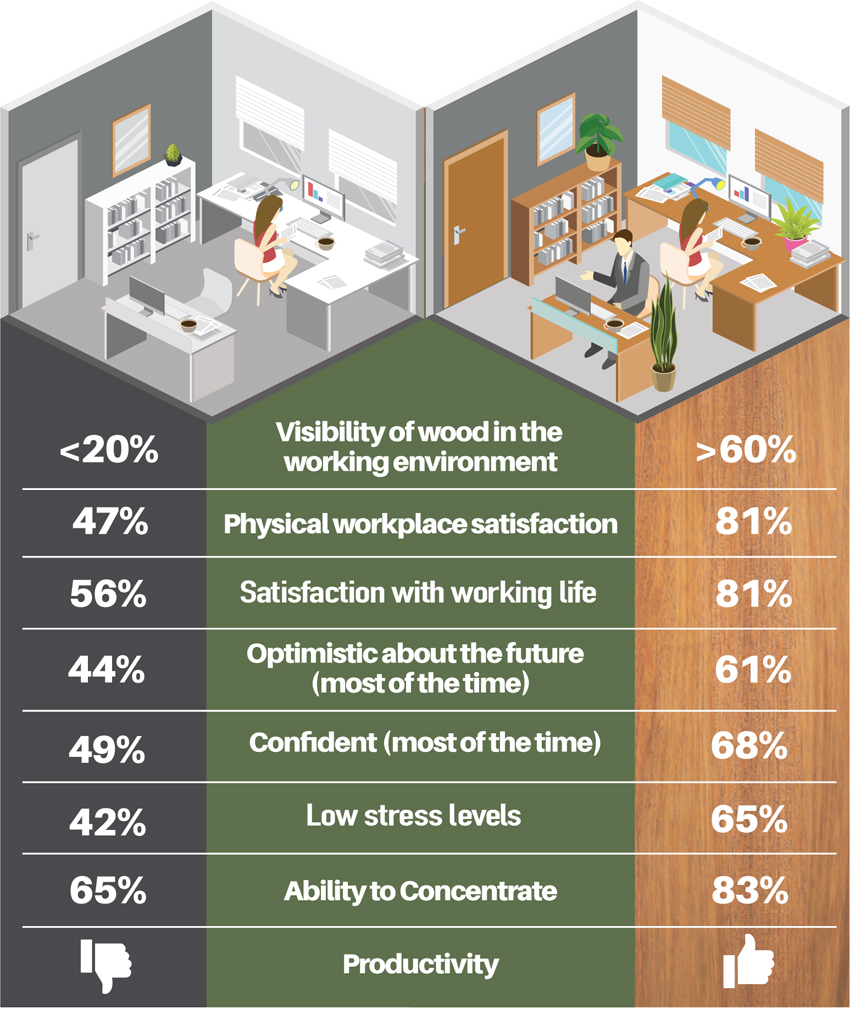
Source: “Workplaces: Wellness + Wood = Productivity”
Other studies have identified improvements in productivity, cognitive performance, and job satisfaction as well as fewer sick days when their workplaces were deliberately designed to incorporate some exposure to nature. A study of 1,000 workers funded by Forest & Wood Products Australia, “Workplaces: Wellness + Wood = Productivity,” found several measurable benefits.27 For example, when an office is designed to incorporate views of nature and natural elements:
- Attendance improves. “On average, workers who are very satisfied with their physical workplace take four less sick days per year compared to those who are very dissatisfied.
- Workplace satisfaction improves when employees are surrounded by natural-looking wooden surfaces. “People in workplaces with less than 20 percent natural-looking wooden surfaces are far less satisfied with both their working life and physical workplace compared to those with a high proportion of wood.”
- Overall productivity increased by 8 percent, and general rates of well-being increased by 13 percent.
Competition for top talent is strong, so many companies strive to create a welcoming workplace that speaks to the company’s unique culture. For example, designers may choose wood for an office structure to provide a warm aesthetic that will help balance the stress of high-tech work that occurs within. The presence of wood within an office environment was found to improve first impressions of potential employees, according to a study in New Zealand.28 When shown photos of office interiors, some with wood and others without, and asked to identify the firm for which they would most like to work, subjects chose those with wood interior design elements. People described the companies whose interiors featured wood with words like innovation, energy, and comfort; the others were described as impersonal and uncomfortable.
Bill Browning from Terrapin Bright Green sums it up in a 2015 article published in People + Strategy, saying that healthier workplaces lead to happier employees. “Biophilic design, design that brings nature into the built environment, has often been regarded as a luxury for employers that want the best possible workplace for their employees or want to showcase their efforts to be more environmentally responsible. Green building efforts traditionally focus on costs of energy, water, and healthy materials—all important topics. Yet, human costs are 112 times greater than energy costs in the workplace. Incorporating nature into the built environment is not a luxury but a sound economic investment in health and productivity. Biophilic design has been shown to improve employee well-being, increase productivity, and boost the bottom line.”29
Retail Customer Experience
In its report, “The Economics of Biophilia,” Terrapin Bright Green quantified the importance of nature in retail spaces, framing the discussion around how natural design elements can be used to draw shoppers in and boost sales for a retail establishment. The report showed that retail customers judge businesses surrounded by nature and natural features, finding them to be worthy of prices up to 25 percent higher than businesses with no access to nature.31
Certainly, part of the allure of nature in a retail space is provided by natural plants that are so predominant in shopping areas. But architects have taken the concept beyond foliage. Natural daylighting is essential; companies like Target and Wal-Mart have reported significantly higher sales in departments that had natural lighting.32
Something as simple as just the presence of exposed wood within the retail establishment gets noticed by shoppers and is also equated with a positive shopping experience.
The COVID-19 pandemic has had a devastating impact on retailers, and challenges are expected to remain for some time. Many expect that consumers will be hesitant to return to stores and malls, giving designers new priorities for creating spaces that foster a sense of health and wellness.

Source: Could Biophilic Design Impact a Brand’s Bottomline?39
Wellness-Oriented Building Standards
In the past few decades, we have seen growing interest in green building standards, promoting sustainable building practices intended to create a healthier global environment. We are now seeing the same trend toward wanting to promote the well-being of building occupants inside. It is another indicator of the growing understanding that design and construction of buildings do matter to the human experience, and recognition that building design holds the potential to contribute to an occupant’s overall sense of well-being.
Like green building standards, wellness-oriented building standards are optional. Some entities may require that a project be designed to include natural elements without specifying a building standard. For example, an urban project may require that a building project include a minimum amount of outdoor space, much like some projects require a minimum number of onsite parking spaces.
The trend has led to one new wellness-focused standard, as well as to the addition of wellness considerations within some existing green building standards.
WELL Building Standard
 Launched in 2014 by the International WELL Building Institute (IWBI), the WELL Building Standard is a global rating system that seeks to provide framework and guidance for design professionals who want to incorporate wellness-focused building features.
Launched in 2014 by the International WELL Building Institute (IWBI), the WELL Building Standard is a global rating system that seeks to provide framework and guidance for design professionals who want to incorporate wellness-focused building features.
WELL describes the building standard as “a holistic rating system for buildings, interior spaces, and communities. WELL integrates design features with improvements to operational and policy protocols to help organizations instill a culture of health. Ten overarching concepts represent the ways that our physical environment can impact our health, well-being, productivity, and our performance. Strategies address performance metrics such as air and water quality, lighting, and thermal comfort, as well as how an environment can promote healthy eating, physical activity, and emotional and cognitive health.”33
Designers evaluate a building’s performance using WELL assessment tools, grounded in more than 100 health and well-being solutions in 10 concept areas. For example, the standard includes design strategies such as access to nature, as well as design strategies that support productivity to help relieve workplace stress and anxiety, reduce absences, and enhance overall perceived health status.
One of the WELL concept areas, Mind, includes strategies designed to promote mental health, addressing factors that influence cognitive and emotional well-being. WELL v2 has added certification standards with building design points that reward things like physical activity with inviting staircases, ergonomic work areas, and more.
IWBI has recently released a new WELL Health Safety Rating in response to the COVID-19 pandemic. The new rating focuses on “operational policies, maintenance protocols, emergency plans, and stakeholder education to address a post-COVID-19 environment now and broader health and safety-related issues into the future.”34
Living Building Challenge (LBC)
 Living Building Challenge (LBC) is a green building standard from the International Living Future Institute (ILFI) that takes a holistic approach to green building, with a goal to create a building environment that optimizes the psychological health and well-being of occupants.
Living Building Challenge (LBC) is a green building standard from the International Living Future Institute (ILFI) that takes a holistic approach to green building, with a goal to create a building environment that optimizes the psychological health and well-being of occupants.
LBC has seven performance categories, called Petals, which include: Place, Water, Energy, Health + Happiness, Materials, Equity, and Beauty. The Health + Happiness Petal, for example, is specifically focused on creating a healthy interior environment, healthy interior performance, and access to nature. The Beauty Petal addresses beauty and biophilia, stipulating design elements that must be represented in the project to qualify. Examples include environmental features, natural shapes and forms, natural patterns and processes, light and space, place-based relationships, and evolved human-nature relationships.
Note: To better promote what it calls “the design, construction, and operations of healthy and restorative buildings,” the IWBI and the ILFI are working to better align the WELL Building Standard and the Living Building Challenge rating systems, with a goal to allow certain projects to meet dual certification.35
Leadership in Energy and Environmental Design (LEED)
 Operated by the U.S. Green Building Council, Leadership in Energy and Environmental Design (LEED) gives designers the ability to earn points for a project by incorporating design measures that are deemed to positively impact the environment, like using sustainable materials or making efficient use of resources. Besides promoting a project’s sustainability features, LEED also acknowledge the importance of designing beneficial spaces for living and working. LEED allows users to apply for pilot credits with LEED v4 by using at least five distinct biophilic design strategies, including material connection with nature, nature of the space, use of indigenous natural materials in the interior finishes of a space, and others.36 For example, a project can earn LEED points by incorporating living walls, sometimes called green walls, into an office space, adding a water feature to a building complex, or featuring exposed wood members and natural rock in a shared space.
Operated by the U.S. Green Building Council, Leadership in Energy and Environmental Design (LEED) gives designers the ability to earn points for a project by incorporating design measures that are deemed to positively impact the environment, like using sustainable materials or making efficient use of resources. Besides promoting a project’s sustainability features, LEED also acknowledge the importance of designing beneficial spaces for living and working. LEED allows users to apply for pilot credits with LEED v4 by using at least five distinct biophilic design strategies, including material connection with nature, nature of the space, use of indigenous natural materials in the interior finishes of a space, and others.36 For example, a project can earn LEED points by incorporating living walls, sometimes called green walls, into an office space, adding a water feature to a building complex, or featuring exposed wood members and natural rock in a shared space.
LEED v4 also has a stronger performance-oriented approach to indoor environmental quality, having added criteria to address things like air quality, lighting, acoustics, and other design factors. Like WELL, LEED has also augmented its program in response to the global pandemic. The LEED Safety First pilot credits address pandemic preparedness and response, workplace reoccupancy steps, sanitation measures, indoor air quality, and more.37
Green Globes
 In 2019, the Green Building Initiative updated Green Globes standards for both Existing Buildings and New Construction, adding a section on Health and Wellness. The new standards consider things like air quality and ventilation, humidity, thermal and acoustic comfort, daylighting, accessibility of staircases, fitness facilities, bicycle commuter facilities, healthy dining options, and more. For example, designers of health-care facilities are asked about measures taken to minimize noise at reception areas to help reduce anxiety and stress on patients and families seeking directions and information from staff.
In 2019, the Green Building Initiative updated Green Globes standards for both Existing Buildings and New Construction, adding a section on Health and Wellness. The new standards consider things like air quality and ventilation, humidity, thermal and acoustic comfort, daylighting, accessibility of staircases, fitness facilities, bicycle commuter facilities, healthy dining options, and more. For example, designers of health-care facilities are asked about measures taken to minimize noise at reception areas to help reduce anxiety and stress on patients and families seeking directions and information from staff.
Healthy Buildings Have a Healthy Future
While much of the research is relatively new, science continues to identify opportunities to change the way we build to promote well-being. We have identified possibilities for buildings to be designed holistically, not only to meet criteria beyond just cost and structural considerations but also achieve social, psychological, and other goals.
This is perhaps one legacy of the pandemic: that we have the potential to change where and how we work, what a school looks like for our children, how a hospital or other health-care facility can help people recover, and how we provide housing for the at-risk in our communities. And we have a growing appreciation for the fact that nature can play a larger role in how we design buildings that will help us feel good. But we still need to know more. There are many opportunities for further research studying the impact of the built environment on all aspects of occupant health and wellness.
In their 2019 article, “Do Experiences With Nature Promote Learning? Converging Evidence of a Cause-and-Effect Relationship,” published in Frontiers in Psychology, authors Ming Kuo, Michael Barnes, and Dr. Catherine Jordan said, “Over 50 studies point to nature playing a key role in the development of pro-environmental behavior, particularly by fostering an emotional connection to nature.”38
This may mean that people who live, learn, or work in sustainably built buildings will, in time, develop a better appreciation for sustainability itself. Healthy buildings have a healthy future.
END NOTES
1U.S. Environmental Protection Agency. 1989. Report to Congress on indoor air quality: Volume 2. EPA/400/1-89/001C. Washington, DC.
2How Architectural Design Can Improve Health and Wellness, Alvarez-Díaz & Villalón, March 1, 2017
3Human-Centred Design; An innovative engagement process that puts wellbeing at the heart of building design, Atkins
4Green Cities: Good Health, University of Washington Urban Forestry/Urban Greening Research
5A Visual Reference for Evidence-Based Design, The Center for Health Design
614 Patterns of Biophilic Design, Improving Health & Well-Being in the Built Environment, Terrapin Bright Green
7The Economics of Biophilia, Why Designing with Nature in Mind Makes Financial Sense, Terrapin Bright Green
8Wood Housing, Health, Humanity, Planet Ark
9Wood in the human environment: restorative properties of wood in the built indoor environment
10Workplaces: Wellness + Wood = Productivity, a report prepared for Forest & Wood Products Australia by Andrew Knox, Howard Parry-Husbands, Pollinate, February 2018; pg. 11
11https://www.nrs.fs.fed.us/pubs/gtr/gtr-nrs-p-39papers/04-heerwagen-p-39.pdf, page 42, Ulrich studies
12Walch J.M., Rabin B,S,, Day R,, Williams J,N,, Choi K,, Kang J,D. The effect of sunlight on postoperative analgesic medication use: a prospective study of patients undergoing spinal surgery. Psychosom Med. Jan-Feb 2005
13Wood and Its Impact on Humans and Environmental Quality in Facilities, International Journal of Environmental Research and Public Health, Kotradyova et al, September 19, 2019
14Do Experiences With Nature Promote Learning? Converging Evidence of a Cause-and-Effect Relationship, Frontiers in Psychology, February 2019, p.2
15Impact of views to school landscapes on recovery from stress and mental fatigue. Landsc. Urban Plan, 2016, abtract
16Do Experiences With Nature Promote Learning? Converging Evidence of a Cause-and-Effect Relationship, Frontiers in Psychology, February 2019, p.2
17Determan, J., Akers, M. A., Albright, T., Browning, B., Martin-Dunlop, C., Archibald, P., & Caruolo, V. (2019). The impact of biophilic learning spaces on student success
18https://www.bdcnetwork.com/back-nature-can-wood-construction-create-healthier-more-productive-learning-environments
19https://makeitwood.org/documents/doc-1253-wood--housing--health--humanity-report-2015-04-00-final.pdf, Pg 6
20University Childcare Centre; International Living Future Institute
21Behavior Changes in Older Persons Caused by Using Wood Products in Assisted Living, Anme et al, Public Health Research, 2012
22Therapeutic Landscapes and Wellbeing in Later Life: Impacts of Blue and Green Spaces for Older Adults; Finlay et al, July 2015, Health & Place
23Seeing Community for the Trees: The Links among Contact with Natural Environments, Community Cohesion, and Crime; BioScience, Volume 65, Issue 12, 01 December 2015, Pages 1141–1153
24Environment and Crime in the Inner City: Does Vegetation Reduce Crime?; M. Kuo and W. Sullivan, May 2001
25Drs. Julian and Raye Richardson Apartments, Architect Magazine, May 20, 2013
26Health, Wellbeing & Productivity in Offices, The Next Chapter for Green Building; World Green Building Council
27Workplaces: Wellness + Wood = Productivity, a report prepared for Forest & Wood Products Australia by Andrew Knox, Howard Parry-Husbands, Pollinate, February 2018
28Ball, R.D., Killerby, S.K and Ridoutt, B.G., First impressions of organisations and the qualities connoted by wood in interior design. Forest Products Journal 2002
29Incorporating Nature into the Built Environment, Healthier Workplaces, Happier Employees, Bill Browning, People + Strategy, Summer 2015
30Case Study: First Tech Federal Credit Union, September 2018, APA-The Engineered Wood Association
31The Economics of Biophilia, Terrapin Bright Green
32The Economics of Biophilia, Terrapin Bright Green
33The Built Environment has a Huge Role to Play in Improving Health and Wellbeing, World Economic Forum Agenda, January 15, 2020
34WELL Health-Safety Rating; International WELL Building Institute
35Living Building Challenge & the WELL Building Standard; Approaches for projects seeking a dual rating
36Designing with Nature, Biophilic Design for the Indoor Environment; LEED BD+C: New Construction LEED 4v; U.S. Green Building Council
37Managing Buildings During COVID-19; U.S. Green Building Council
38Do Experiences With Nature Promote Learning? Converging Evidence of a Cause-and-Effect Relationship; Ming Kuo, Michael Barns, Catherine Jordan; Frontiers in Psychology, February 19, 2019
39www.thinkwood.com/news/biophilic-brands-can-wood-and-nature-boost-the-bottom-line-2

 Launched in 2014 by the International WELL Building Institute (IWBI), the WELL Building Standard is a global rating system that seeks to provide framework and guidance for design professionals who want to incorporate wellness-focused building features.
Launched in 2014 by the International WELL Building Institute (IWBI), the WELL Building Standard is a global rating system that seeks to provide framework and guidance for design professionals who want to incorporate wellness-focused building features. Living Building Challenge (LBC) is a green building standard from the International Living Future Institute (ILFI) that takes a holistic approach to green building, with a goal to create a building environment that optimizes the psychological health and well-being of occupants.
Living Building Challenge (LBC) is a green building standard from the International Living Future Institute (ILFI) that takes a holistic approach to green building, with a goal to create a building environment that optimizes the psychological health and well-being of occupants. Operated by the U.S. Green Building Council, Leadership in Energy and Environmental Design (LEED) gives designers the ability to earn points for a project by incorporating design measures that are deemed to positively impact the environment, like using sustainable materials or making efficient use of resources. Besides promoting a project’s sustainability features, LEED also acknowledge the importance of designing beneficial spaces for living and working. LEED allows users to apply for pilot credits with LEED v4 by using at least five distinct biophilic design strategies, including material connection with nature, nature of the space, use of indigenous natural materials in the interior finishes of a space, and others.36 For example, a project can earn LEED points by incorporating living walls, sometimes called green walls, into an office space, adding a water feature to a building complex, or featuring exposed wood members and natural rock in a shared space.
Operated by the U.S. Green Building Council, Leadership in Energy and Environmental Design (LEED) gives designers the ability to earn points for a project by incorporating design measures that are deemed to positively impact the environment, like using sustainable materials or making efficient use of resources. Besides promoting a project’s sustainability features, LEED also acknowledge the importance of designing beneficial spaces for living and working. LEED allows users to apply for pilot credits with LEED v4 by using at least five distinct biophilic design strategies, including material connection with nature, nature of the space, use of indigenous natural materials in the interior finishes of a space, and others.36 For example, a project can earn LEED points by incorporating living walls, sometimes called green walls, into an office space, adding a water feature to a building complex, or featuring exposed wood members and natural rock in a shared space. In 2019, the Green Building Initiative updated Green Globes standards for both Existing Buildings and New Construction, adding a section on Health and Wellness. The new standards consider things like air quality and ventilation, humidity, thermal and acoustic comfort, daylighting, accessibility of staircases, fitness facilities, bicycle commuter facilities, healthy dining options, and more. For example, designers of health-care facilities are asked about measures taken to minimize noise at reception areas to help reduce anxiety and stress on patients and families seeking directions and information from staff.
In 2019, the Green Building Initiative updated Green Globes standards for both Existing Buildings and New Construction, adding a section on Health and Wellness. The new standards consider things like air quality and ventilation, humidity, thermal and acoustic comfort, daylighting, accessibility of staircases, fitness facilities, bicycle commuter facilities, healthy dining options, and more. For example, designers of health-care facilities are asked about measures taken to minimize noise at reception areas to help reduce anxiety and stress on patients and families seeking directions and information from staff.

